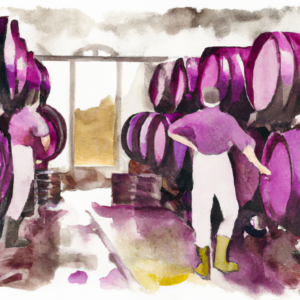Cooperage is the process of making wooden barrels used for storing and aging wine. It involves the selection of the right type of wood, shaping it into staves, and assembling them into a barrel. Cooperage has a significant impact on the character and quality of wine, as the type of wood used and the way the barrel is toasted can influence the flavor, aroma, and texture of the wine.
The art of cooperage has been around for centuries, with the first documented use of wooden barrels for wine storage dating back to ancient Greece and Rome. Over time, the craft of cooperage has evolved to become a highly specialized field, with skilled craftsmen known as coopers who are trained to create barrels that meet the specific needs of winemakers.
One of the key factors that determines the quality of a wine barrel is the type of wood used. The most common types of wood used for wine barrels are oak, chestnut, and acacia, although other woods such as cherry, mulberry, and ash may also be used. Oak is by far the most popular choice, as it imparts desirable flavors and aromas to the wine while also providing a stable and consistent environment for aging.
Within the category of oak, there are several different species of oak that may be used for wine barrels. The two most common species are Quercus alba, also known as American white oak, and Quercus robur, also known as French oak. American white oak is typically less expensive than French oak and is known for imparting more intense flavors and aromas to the wine. French oak, on the other hand, is considered to be of higher quality and is known for imparting more subtle and complex flavors and aromas.
In addition to the type of wood used, the way the barrel is toasted also has a significant impact on the flavor and aroma of the wine. During the toasting process, the inside of the barrel is exposed to heat, which caramelizes the natural sugars in the wood and creates complex flavors and aromas in the wine. The level of toasting can range from light to heavy, with each level producing different flavors and aromas in the wine. For example, a barrel that is lightly toasted may impart flavors of vanilla and spice, while a heavily toasted barrel may impart flavors of smoke and char.

The size of the barrel is another important factor to consider in cooperage. The most common sizes of wine barrels are the standard Bordeaux barrel, which holds 225 liters, and the Burgundy barrel, which holds 228 liters. However, barrels may also come in a range of other sizes, including smaller sizes such as 59 liters and larger sizes such as 500 liters or more. The size of the barrel can impact the rate of aging, as smaller barrels tend to age the wine more quickly than larger barrels.
Cooperage also plays a significant role in the economics of winemaking. Wine barrels can be quite expensive, with high-quality barrels costing several thousand dollars each. Winemakers must balance the cost of the barrels against the potential benefits they provide, such as improved flavor and aroma in the wine and increased value in the marketplace.
In addition to their role in wine aging, wine barrels are also used for the fermentation of wine. This is known as barrel fermentation, and it involves adding grape juice to a barrel and allowing it to ferment inside the barrel. Barrel fermentation can produce unique and complex flavors and aromas in the wine, as the yeast and bacteria present in the barrel can interact with the wine in different ways than they would in a stainless steel tank.
In conclusion, cooperage is a critical aspect of winemaking, and the choice of barrel can have a significant impact on the final product. The type of wood, toasting level, barrel size and shape, and many other factors can all influence the flavor, aroma, and aging potential of the wine. From the forests of France to the wineries of California, cooperage is a tradition that continues to shape
the world of wine. Whether you are a winemaker, a wine enthusiast, or simply a lover of fine wine, the role of cooperage in wine production is a fascinating and important aspect of the wine world.
It is estimated that the global demand for wine barrels is around 1.5 million barrels per year, with the majority of these barrels being made from oak. The oak barrels are used not only for fermentation but also for aging and maturing the wine, with some wineries reusing barrels for several years.
Tags, Tags, #hashtags, Tags